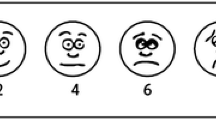Abstract
Nasal blockage is a common complaint in Family Practice. Decongestive nosedrops are frequently employed therapeutic measures. Due to a considerable risk of abuse and side effects, alternatives are wanted. The purpose of this study was to elucidate to what extent ENDS might represent an alternative to decongestive nose sprays (DNS). The effects of DNS (xylometazolin) and ENDS (BreatheRight®) on subjective and objective nasal blockage were compared in 89 patients. Main outcome measures were recordings of nasal symptom scores on visual analogue scales (VAS), minimal cross-sectional areas (MCA) and nasal cavity volumes (NCV) as measured by acoustic rhinometry (AR), and peak nasal inspiratory flow (PNIF). ENDS significantly increased the MCA and the NCV in the anterior 0.0–3.0 cm of the nose compared to DNS, but had no effect on MCA from 3.0 to 5.4 cm behind the nostrils. In contrast to DNS, ENDS had no effect on the posterior NCV. ENDS and DNS gave comparable increase in nasal inspiratory flow as measured by PNIF, and in the subject’s own experience of nasal obstruction. ENDS may represent an alternative to DNS as a measure against nasal blockage.







Similar content being viewed by others
References
Dahl R (1993) Rhinitis and asthma. In: Mygind N, Naclerio R (eds) Allergic and nonallergic rhinitis. Munksgaard, Copenhagen, pp 184–188
Lofaso F, Coste A, d’Ortho M, Zerah-Lancner F, Delclaux C, Goldenberg F (2000) Nasal obstruction as a risk factor for sleep apnoea syndrome. Eur Respir J 16:639–643
Craig T, Teets S, Lehman E, Chinchilli V, Zwillich C (1998) Nasal congestion secondary to allergic rhinitis as a cause of sleep disturbance and daytime fatigue and the response to topical nasal corticosteroids. J Allergy Clin Immunol 101:633–637
Lucente F (1989) Rhinitis and nasal obstruction. Otolaryngol Clin North Am 2:307–318
Fornadley J (1999) The stuffy nose and rhinitis. Med Clin North Am 83:1–12
Fadal R (1987) The medical management of rhinitis. In: English G (ed) Otolaryngology. Lippincott, Philadelphia, pp 1–25
Corey J, Houser S, Bernard A (2000) Nasal congestion: a rewiev of its etiology, evaluation, and treatment. Ear Nose Throat J 79:690–703
Griffin J, Hunter G, Ferguson D, Sillers M (1997) Physiologic effects of an external nasal dilator. Laryngoscope 107:1235–1238
Shaida A, Kenyon G (2000) The nasal valves: changes in anatimy and physiology in normal subjects. Rhinology 38:7–12
Graf P (1999) Adverse effects of benzalkonium chloride on the nasal mucosa: allergic rhinitis and rhinitis medicamentosa. Clin Ther 21:1749–1755
Hilberg O (2002) Objective measurement of nasal airway dimensions using acoustic rhinometry: methodological and clinical aspects. Allergy 57:5–39
O’Kroy J, James T, Miller J, Torok D, Campbell K (2001) Effects of an external nasal dilator on the work of breathing during exercise. Med Sci Sports Exerc 33:454–458
Kirkness J, Wheatley J, Amis T (2000) Nasal airflow dynamics: mechanisms and responses associated with an external nasal dilator strip. Eur Respir J 15:929–936
Wihl J-A, Malm L 1988 Rhinomanometry and nasal peak expiratory and inspiratory flow rate. Ann Allergy 6:50–55
Taverner D, Bickford L, Latte J (2002) Validation by fluid volume of acoustic rhinometry before and after decongestant in normal subjects. Rhinology 40:135–140
Lorino A, Lofaso F, Drogou I, Abi-Nader F, Dahan E, Coste A 1998 Effects of different mechanical treatments on nasal resistance assessed by rhinometry. Chest 114:166–167
Clark R, Jones A, Richardson H (1995) Peak nasal inspiratory flow-the plateau effect. J Laryngol Otol 109:399–402
Pevernaige D, Hamans E, Van Cauvenberge P, Pauwels R (2000) External nasal dilatation reduces snoring in chronic rhinitis patients: a randomized controlled trial. Eur Respir J 15:996–1000
Slavin R (1994) Sinopulmonary relationships. Am J Otolaryngol 15:18–15
DuBuske L (1999) The link between allergy and asthma. Allergy Asthma Proc 20:341–345
Vermoen C, Verbraak A, Bogaard J (1998) Effect of a nasal dilator on nasal patency during normal and forced nasal breathing. Int J Sports Med 19:109–913
Author information
Authors and Affiliations
Corresponding author
Rights and permissions
About this article
Cite this article
Høyvoll, L.R., Lunde, K., Li, H.S. et al. Effects of an external nasal dilator strip (ENDS) compared to xylometazolin nasal spray. Eur Arch Otorhinolaryngol 264, 1289–1294 (2007). https://doi.org/10.1007/s00405-007-0345-6
Received:
Accepted:
Published:
Issue Date:
DOI: https://doi.org/10.1007/s00405-007-0345-6




